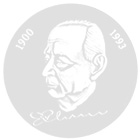Invention of the today so-called e-mail
Raymond S. Tomlinson – How a little glyph altered the way mankind communicate
Remember the times when huge loads of memos, documents, and reports were piled up on your office desk? That must have been in the pre-Internet era more than twenty years ago. Some 40 years ago, Ray Tomlinson, then an early to midcareer computer engineer working for Bolt, Beranek and Newman (BBN), experimented with data transmission between the monstrous computers of those days. Worldwide electronic exchange of large documents within a few seconds and work environments such as the paperless office were still beyond imagination. Packet switching was then a relatively new technique and, funded by the U.S. Department of Defense, the Advanced Research Projects Agency Network (ARPANET) had just become a fully operational and fast growing system. Legend has it that router units (then called Interface Message Processors, IMP’s) were configured with 24 kilobytes (!) of expandable core memory and with a 16-channel Direct Multiplex Control (DMC) functioning as direct memory access unit. Just recently, at the 1970 Spring Joint Computer Conference, Stephen Carr, Stephen Crocker and Vinton Cerf had published their seminal paper “Host-Host Communication Protocol in the ARPA Network”, Tomlinson’s basic idea was to send text messages over the ARPANET using the available TENEX (TEN-EXtended) operating system (OS) in use on Digital Equipment Corporation (DEC) PDP-10 platforms. In 1971, Ray Tomlinson sent the first network email between two BBN-TENEXA (BBNA) machines which were actually PDP-10 computers with 48K (nowadays exotic) 36-bit words of magnetic core memory. Surprisingly enough, very soon after these successful trials, by 1973, email already constituted 75 percent of ARPANET traffic. It took yet another twenty years before, with the availability of modern Internet technology, email became what it is today – the Internet’s most important and widely used service. From its inception in 1971, email was originally designed as an asynchronous file transfer medium.
It is generally agreed that Tomlinson’s first contribution was to find a way to define a unique email address in a computer network by expressing it in a “user@remote” format. Obviously, it was his idea to insert the “commercial at” sign @ as a separator glyph between user name and the unique machine identifier.
The second contribution has to do with how files are being transferred. Tomlinson wrote a file transfer service (called CPYNET) which he integrated into the existing TENEX local messaging system, called SNDMSG. With this additional CPYNET protocol feature, SNDMSG became the first “smart” message transfer agent (MTA). It could take electronic messages and, within the computer network and over arbitrarily long distances, almost instantly deliver them to the designated remote user’s mailbox. Note, however, that these experimental MTA’s operated differently from what is required by virtue of today’s file transfer protocol (FTP) standards.
Going back in time, it would be unfair to blame Mr Tomlinson for an the adverse side effects that inevitably came along with modern email communications. Back in 1971, spam bombing, spoofing, worms, phishing attacks, and all kinds of privacy issues had yet to come upon us. As stated at the beginning, we should keep in mind that email services almost instantly blew away from our office desks an of that nasty paper load, just to replace it by even vaster amounts of electronic mail on our hard disc drives. Things have changed, to say the least.
Celebrating the 40th birthday of the first email transfer has inspired the jury to honor Ray Tomlinson as the Eduard Rhein Foundation’s 2011 Cultural Award winner.
Prof. Dr.-Ing. Horst Bessai
University of Siegen
